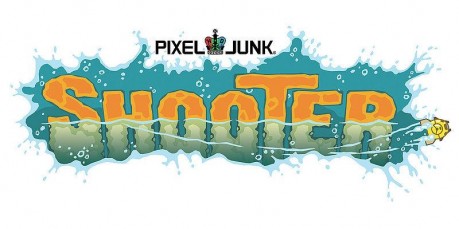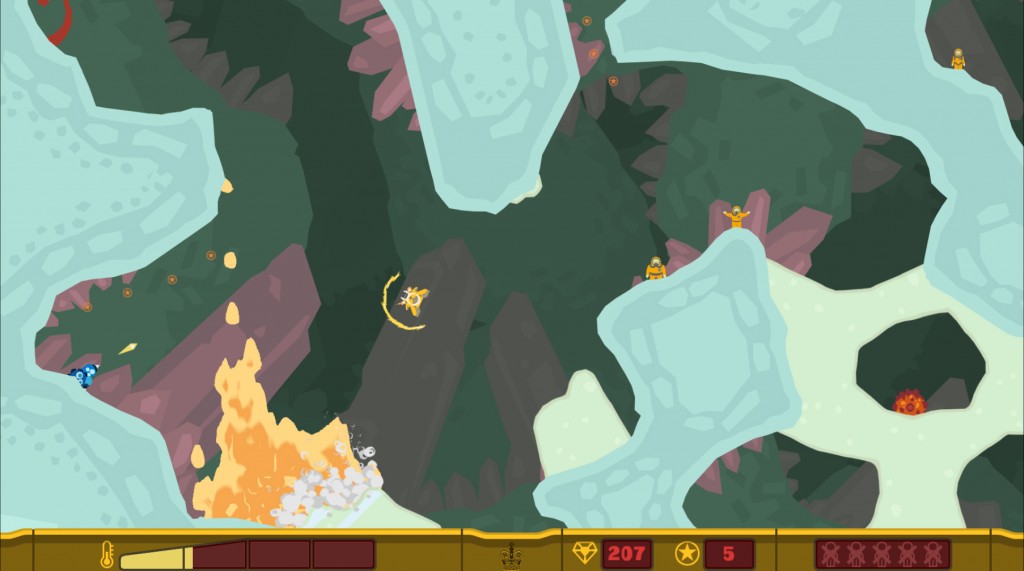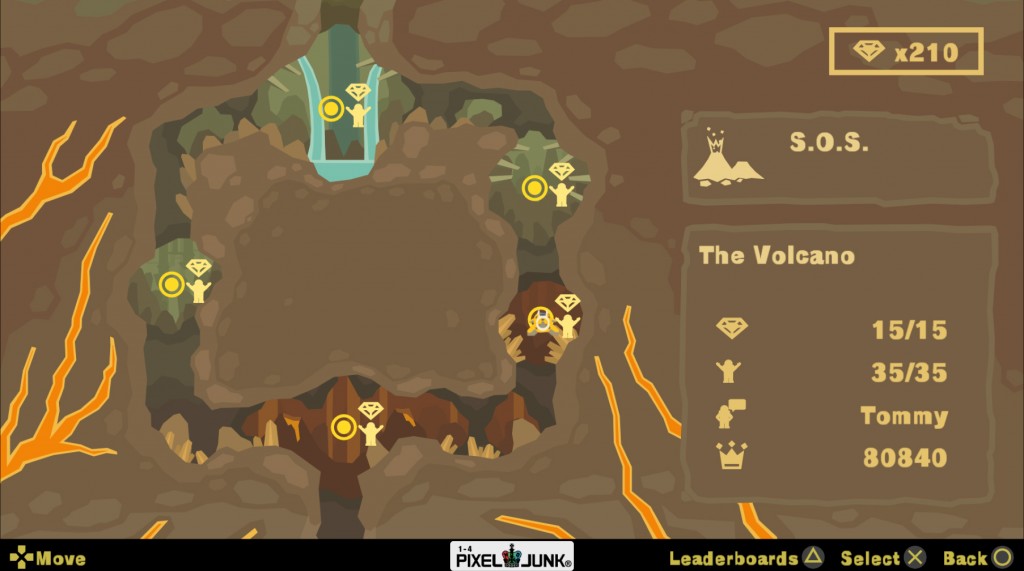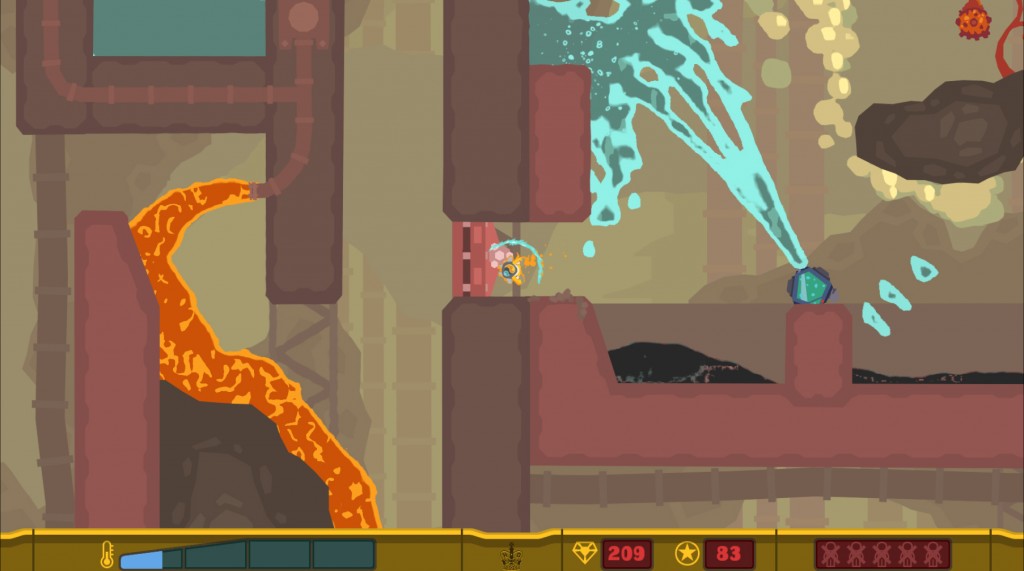Back in August, I committed to doing one decon per month. It only took two months for me to fall off track. Now I have to play catch up…but better late than never, right?
This month I take a look at another downloadable title, this time for the PlayStation 3. I briefly played PixelJunk Shooter at E3, and although I was impressed with its visual style and ease of use, I didn’t know how long the game would be able to keep my attention with its simple mechanics. I picked it up based on the developer’s reputation for quality, and although it was a bit on the short side, it does a lot of things very well.
 PixelJunk Shooter
PixelJunk Shooter
Developer: Q Games
Genre: Shooter / Puzzle
Metacritic: 86
Price: $9.99
Length: 4-6 hours
Background
PixelJunk Shooter is the fourth entry in the Q Games’ PixelJunk series of PSN titles, following most recently the critically acclaimed PixelJunk Eden. It follows suit with the series’ reputation for high production value and polish. On the surface, the game isn’t very special – it’s a space-cavern exploration adventure along the lines of Subterrania for the Sega Genesis (I feel like this dates me), but its puzzle design is so innovative that it creates a very fresh experience. Its difficulty stems from its fluid-based physics puzzles, all of which force the player to think carefully about every move. The game isn’t particularly difficult, but it’s extremely clever.
Gameplay
Shooter consists of three worlds that have roughly five levels each. Each level is broken up into a handful of areas where a handful of crew members from the ERS Piñita Colada have been stranded. The player is tasked with rescuing all of the survivors in each area, without letting more than five die during the course of a level. All survivors must be rescued or killed (no one gets left behind) before access to the next area until the the final area is reached, where an escape gate opens to leave the level. The player cannot backtrack to areas they have completed without replaying the entire level. In the final area of each world, the player encounters a boss that must be defeated to continue on to the next world.
The player’s health is displayed on a heat gauge at the bottom of the screen. As the ship takes damages or flies around magma, it gets warmer. If it gets too hot, it stalls out or explodes. The ship’s temperature gradually decreases when it is far away from hazards, and it cools off instantly when submersed in water.
The player’s deaths are not tracked – if you die at any time during a level, you start back at the beginning of the area. The only way to fail a level is to allow the lost survivor counter to reach five. The player can earn 1-UPs during the game that subtract one from that counter. If the player restarts an area after accidentally killing a survivor, the survivor will reappear in the level but the penalty for losing him does not reset.
The entire game is also playable in co-op mode. Playing with a friend almost completely eliminates the penalty for failure because it’s rare for both players to die at once. After dying in co-op mode, it only takes five seconds to respawn. The level only ends if both players die, meaning if one player can stay alive, it’s as if the death never happened.
Mechanics
Although rescuing survivors and collecting diamonds are the primary objectives, the meat of the game is found in manipulating various fluids. There are multiple kinds of fluids and gasses, and the player can move them around the level by blasting apart the rock that holds them back in each area’s caverns. As the game progresses, the player learns a system of rules for how fluids interact with each other that become the basis for most of the game’s puzzles:
- Water mixed with magma yields solid ground
- Water mixed with oil yields gas
- Water mixed with ice yields ice
- Magma ignites gas
- Magma melts ice
- Magma evaporates oil
Flying near magma or flying through gas slowly heats up the ship. Flying into magma or oil usually results in an instant death. The player must also consider how the fluids affect the survivors: they can survive forever in water or a short time in gas, but they instantly die in lava or oil. They can also get trapped in ice and freeze to death.
In some areas, the player will be able to use a dock to temporarily change the ship’s functionality via Metroid-esque “suits.” They might change the ship’s primary fire to shooting water or lava instead of missiles, or they might change how the suit interacts with the environment (i.e. reversing effects of water and lava). Each suit lends itself towards a particular type of puzzle, but they have downsides as well. The Water Suit is great for neutralizing lava or creating ice walls, but it takes away the player’s ability to attack most enemies because it can only shoot water or pull away chunks of ice with the grapple. The Magma Suit is powerful for melting ice and killing most enemies quickly, but it’s easy for players to accidentally shoot themselves with magma that gets deflected from walls and it can make navigating through gas very dangerous. One exception is the “Anti-Magnet” suit that repels the magnetic oil substance found in the later levels – allowing the player to guide the fluid around simply by flying near or through it. It’s a lot of fun to use, but it’s overpowered compared to the other suits because there isn’t a downside to using it since the ship retains all of its normal abilities. I felt like the second world was harder than the final one as a result.
Once a suit is equipped, there is no way to discard it until the area is completed. Suits reset at the beginning of each area, and there is never more than one suit available in any given area. Part of me feels like this is an obvious missed opportunity, but I also realize that it keeps thing simple. As it stands, the player can never get stuck to a point where the level must be reset, and it would likely be easier to reach a dead end when combining the abilities of each suit. That’s a good thing, but I still wish the game had more puzzles that played on the weaknesses of each suit. I found that I had to think the hardest when I was worried about dying more than when I was trying to get to an exit, and most of the suit puzzles minimize those situations.
Aesthetics
The game uses a simplistic cel-shaded style similar to the other titles in the PixelJunk series. It lends itself particularly well to the fluid animations. At first I was a little bit confused about which kinds of surfaces I could shoot through because there isn’t much difference in their appearances aside from shading, but I quickly adapted to the game’s world and didn’t have any trouble after the first couple of levels. Then again, I was lucky enough to be playing on a massive HDTV in 1080p, so it might be a bit more difficult to see with a poor contrast ratio on a standard tube TV. The characters (enemies, ships, bosses) have minimal animation, but they still manage to feel alive in the context of the game. The style is nothing revolutionary, but it works well and I have a hard time picturing this game without it.
The game’s soundtrack is made up of the series’ trademark smooth electronic beats. There’s some subtle procedural music alteration during particular events in the game. When the player is engaged in combat, the percussion track goes from ambient to driving. It helps create a sense of urgency for dealing with enemies without being intrusive or jarring like a flashy graphical effect could be.
If you’ve played other PixelJunk games, Shooter’s aesthetics will be instantly familiar but they come across as far more polished than its predecessors.

Controls
The player moves his spaceship around with the left stick and changes its orientation with the right stick. Spinning the right stick performs a spin-attack that can dig away soil or deflect enemy fire. Either of the right triggers can be used to fire the currently equipped weapon, and holding down one of the right triggers operates as a secondary fire. The left triggers fire the grapple used to pick up items or survivors. None of the face buttons are used during gameplay.
Without its simple controls, the game would quickly over-complicate itself. The ship’s movement is just floaty enough to match the game’s outer-space setting, but it’s tight enough so that the player doesn’t blame the game for running into hazards. There is a very slight auto-aim correction on the primary fire, but I was only frustrated with myself (not the game) when stray bullets hit survivors.
The biggest gripe I have with the controls is the lack of a good tutorial. There are “how to play” slides available for viewing before the game, but like most players, I jumped in and figured I’d learn as I go. As a result, I was stuck for about 30 minutes on one level trying to figure out how to pass an obstacle when the solution was to spin-attack through it. I had never needed it before, and I was well past halfway through the game, so I simply didn’t know about the spin-attack ability. A playable tutorial of some sort is a necessity in almost any game when the controls aren’t self-explanatory – even overlays that explain the controls during the main game would have been sufficient, but it’s not right to assume the player will read a boring set of slides before jumping into the action.
Another frustration is the lack of a decent camera for the co-op mode. If one player moves off the screen into a secret area or proceeds to the exit, the other player is instantly transported there. Similarly, player two will die via a Sonic the Hedgehog 2 drowning-style countdown timer if player one goes too far away. Perhaps a dynamic splitscreen system could have solved the problem?
Where’s the Fun?
This is the classic example of a game being better than the sum of all its parts. The gameplay is simple enough to be easy to pick up and play with a friend, but complex enough to avoid turning into a collect-a-thon. There’s very little change in difficulty, but there’s a lot of depth to the game’s puzzles (pun intended) and it makes you feel clever every step of the way even if there isn’t any sort of real penalty for failure. That lack of a fail state allows the game to offer a large variety of puzzles without getting too frustrating.
The game also does an excellent job of giving the player feedback for every action. IÂ think it’s what made Uncharted 2 such a success, but on a smaller scale: even if the player is on a linear path, the game can fabricate an exhilarating experience by making players feel like they have a tangible impact on everything in the world. Shooter gets away with it by maximizing the use of its fluid animations. The player has minimal control over the fluids, but that limited influence has massive amounts of feedback because of the various ways the fluids can interact. The player feels directly responsible for every cool chemical reaction and every pretty visual effect.
Similar to PixelJunk Eden, the game displays the number of remaining collectibles in each level to encourage completionism. Survivors re-appear on each playthrough, but the diamonds do not. At first I was aggravated that I was going to have to redo all the puzzles and get each survivor all over again if I wanted to find every diamond I missed on my first playthrough, but then I realized that collecting every diamond would be a boring challenge if the game was stripped of its puzzles. Then I found out that on subsequent playthroughs, the game also enables a time-trial challenge with an online leaderboard. On paper, these features are obvious and certainly nothing innovative, but they add a good deal of replayability to an otherwise short game.
What’s Next?
Q Games has already announced that they’re working on PixelJunk Shooter 2, a very uncharacteristic move for a team that hasn’t made a sequel before. The EP, Dylan Cuthbert, says that the team was able to get all their big ideas into the first game during development, but there were still a lot left on the drawing board. I’m looking forward to see where they take it – PixelJunk Shooter is a lot of fun, but there’s also a lot of untapped potential.




0 Comments
Trackbacks/Pingbacks